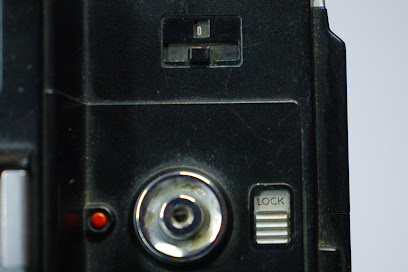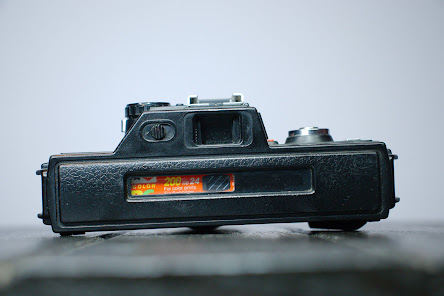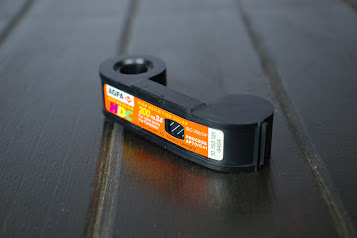Keeping up with film cameras, this post will be looking at a quite unique and interesting looking cameras. That is the Minolta 110 Zoom SLR.
The
Minolta company started in 1928 and was first named Nichi-Doku Shashinki Shoten,
which meant Japan/German camera vendor (The Friedman Archives 2024). The
company’s founder Kazuo Tashima, was part of the import business importing
camera designs (mostly from Germany) and then re-branding them for the Japanese
market (Jacoby 2023).
At
first, Nichi-Doku Shashinki Shoten, sold camera under the brand name Nifca
(meaning “(NI)ppon (F)oto (CA)meras” according to Photographica Pages), that
where cameras modelled and altered versions of cameras sold by Neumann &
Heilemann. But by the 1930s, Neumann & Heilemann, split from Nichi-Doku
Shashinki Shoten after an increase in strikes and labour disputes and thus Nichi-Doku
Shashinki Shoten was forced to re-organised (Jacoby 2023). All this happened in
1931 and 1932 when the company changed again to Molta Goshi-gaisha, which meant
“(M)echanismus (O)ptik und (L)insen von (TA)shima. The product names were
changed. They continued to handle the marketing of their own cameras until an
agreement was reached with Asanuma Shokai. (The Sirius and Arcadia were also
distributed up to this point by Misuzu Shokai as the Lomax and Eaton). When
Asanuma took over distribution the camera model names changed again. In 1931
and 1932 the German engineers left to form their own company, Neumann and Heilemann…”
(Photographica Pages). In 1933, the name Minolta appeared and stood for “Mechanisms, Instruments, Optics,
and Lenses by Tashima, highlighting the fact that Tashima was now
getting serious about the “Made in Japan” qualities of his machines.” From this
they produced a line of Vest Pocket Cameras (Jacoby 2023).
Then
in 1937 the company changed their name to Chiyoda Kogaku Seiko K.K and “was
also sometimes shown as Chiyoko from (CHIYO)da (KO)gaku. The name is Japanese
and implied that the company would last for a thousand generations. That same
year, Asanuma dropped all of their other camera lines and began to market
Chiyoda products exclusively. By this point, all of the products carried the
Minolta name…” (Photographica Pages).
This
lead to them introducing a brand new line of camera models that was ignored by
the Nifca brand that focused on the high-end market (Jacoby 2023). By the 1940s
Minolta released the Rokkor lenses, which was used for military operations
(Subclub 2016) and was exclusively working for the military in 1943 when
civilian production was stopped and thus made them a target for the allied
forces (Photographica Pages).
But
even after the war, when the economy was falling apart, the Minolta brand
bounced back after releasing the first post-war camera, the Semi IIIa by 1946
(Subclub 2016) and by 1953 started manufacturing SLR cameras, starting with the
Minolta SR-2 (Aperture Preview 2019). Then by 1961, the first interchangeable
lens SLR cameras (Subclub 2016).
 |
| Semi IIIa. Image Source: https://www.collection-appareils.fr/minolta/images/semi_minolta_IIIa.jpg |
.jpeg) |
| Minolta SR-2. Image Source: https://upload.wikimedia.org/wikipedia/commons/f/f8/Minolta_SR-2A.JPG |
The
company changed its name to Minolta in 1962, “reflecting the brand awareness
the name carried. By this time, it had eschewed copying products to instead
favor innovation. It had also branched out into producing planetariums, office
equipment and binoculars…” and by 1972 worked with Leitz (Photographica Pages).
From
then on Minolta worked not only on SLR cameras, but “produced many different
types of cameras throughout their entire history. Minolta produced rangefinders
cameras, TLR cameras, 110 cameras, 126 cameras even 16mm still cameras and
other photography related equipment like scanners, movie cameras and light
meters. They had their money in almost every photography market and produced
great cameras while pushing technology forward through innovation and
experimentation…” (Aperture Preview 2019).
But
this upward trajectory would eventually fall when Minolta stopped manufacturing
professional photographic cameras in 1976-1999, due to the majority of their
sales coming from their easy use consumer cameras. Minolta soon realised their
mistake, because “most consumers like to buy less expensive models of renowned
brands, and renown in the camera business comes from professional usage. About
the time when Minolta abandoned the professional market, the Harvard Business
School published a case study about a similar business decision by the Hanson
ski boot company. Once Hanson stopped manufacturing ski boots for racers, its
consumer boot business evaporated and within three years Hanson went bankrupt.”
(Digital Deliverance 2009).
For
a while it did seem to work, with Minolta not doing that bad and even one
upping the completion with their introduction of the first auto focus SLR. But
this wouldn’t be enough because “its consumer market sales eventually eroded. Plus,
by then, no matter how it tried, Minolta could no longer gain a foothold with
professionals. A new generation of professional photographers associated the company
as only a consumer camera manufacturer, despite its able technology and history…”
(Digital Deliverance 2009).
By
2003, Minolta merged with Konica (Aperture Preview 2019), but this didn’t save
the company as it lost approximately $408 million by 2005 (Digital
Deliverance 2009). Although they did release “a very innovative DSLR, the
Maxxum 7D, but by then they had lost their momentum in the marketplace. They
ended up selling their digital camera line to Sony in 2006, and have
discontinued camera manufacture altogether…” (Photographica Pages).
.jpeg) |
| Maxxum 7D. Image Source: https://www.dpreview.com/files/p/articles/1430251523/Images/frontview.jpeg |
Now
for the object of this post, the Minolta 110 Zoom SLR. This camera was released
in 1976 and has an interesting history. According to Subclub (2016):
“By
the early 1970's, the 16mm camera market was so successful that Kodak decided
it wanted a piece of the pie. It released its 110 camera line with an enormous
media blitz. Millions of people, who had never heard of 16mm cameras, suddenly
wanted a tiny camera. It resulted in the death of the 16mm camera, but Minolta
was able to get into the 110 camera market immediately. It was easy for them
because of their history with 16mm cameras. Unlike most 110 cameras, Minolta
only made high quality 110 cameras, like the 110 Zoom SLR of 1976. It was the
first 110 in an SLR design, and only the second with a zoom lens.
Fully-automatic, aperture-priority exposure. The lens was a 25 - 50mm
(f4.5-16.0) with close-focusing capability (focusing to 11 inches). Speeds of
10 seconds through 1/1000. X (1/150) and B settings. Cds meter (not
through-the-lens) with exposure compensation control. LED's in viewfinder
warn of over- and under-exposure, and low battery power. Built-in lock on the
shutter release, tripod socket, hot shoe, tripod socket, battery check, pop-out
lens shade and cable release thread. And sharp, SHARP pictures to boot.”
The camera has a very strange and interesting design. The first thing that stood out to me is the Tripod socket, that is on the side instead of on the bottom. This means that the camera is mounted vertically.
When
in handheld, the camera can be held in either vertically or horizontally. It
just depends on what the user finds comfortable.
.png) |
| Page 10 from the Owner's Manual |
The second thing that stood out is the lens, which is fixed and is a Minolta Zoom Rokkor-Macro 25-50mm with a F/stop of 1:4.5. The lens is weird, because it feels counter intuitive to the rest of the body. By this I mean the camera is meant to be an on the go camera that is slick and small to take anywhere, but instead, as Theo (2018) puts it: “Being such a thin camera vertically, the lens protrudes at the front giving it a slightly front heavy look…”
The
lens has two functions: zoom in/out, with the inner ring or the knurled
zooming ring that switches between normal (25mm) and short telephoto lens
(50mm).
The
lens also has a macro range. This is activated by moving the knurled zooming
ring to 25mm and then gently pushing the knurled zooming ring back and aligning
the orange line next to the M with the white line.
.png) |
| Page 25 from the Owner's Manual |
The
second function is the focus setting, done with the outer ring (the Focus
Collar), that like the Olympus MO30 (see post for more information), moves the
lens backwards and forwards, as if zooming in/out. But it is purely used to
help put the subject into focus.
Next
to the lens is the Electric Eye or the “Cds meter, which is linked to an
aperture control dial. Aperture selection ranges from f/4.5 through to
f/16. This also automatically controls the shutter speeds which range
from 1/1000s through to 10 seconds. The lens can take filters, which will
not be metered for, with a 40.5mm thread.” (Theo 2018)
On top of the camera is the “… hump for the prism…” (Theo 2018)
… And on this hump is the Shutter Setting Selector, which is changed by pressing in the silver button (selector release) on the side and turning the dial. There are three settings. A is automatic, which automatically adjusts the shutter speed according to the settings made on the aperture, f-number, zoom, focus etc.
The X, sets the shutter speed to 1/150 sec. and the B is bulb, a setting that means the “shutter will open when the shutter release or cable-release plunger is pushed and remain open until it is released,” (page 21 of the manual). In both cases the user must make sure they set up the camera correctly to correspond the shutter speed set by the dial.
Next
to the Shutter Setting Selector, is the hot shoe plate, which is used for an
external flash, which was one of the camera’s accessories.
.png) |
| Page 29 of the Owner's Manual |
Next
to the Hump, (in a neat little row) is a red button, the Battery-check Button,
used for (and I can’t believe I am typing this out even though it is obvious),
to check the battery life! Next to that is the Shutter release button (which is
self-explanatory) and next to that is the Shutter-release switch, with two
modes the Lock and On. This turns the camera on and off.
Above
these three buttons is the Exposure-adjustment control and the Adjustment-factor
window. This is used to increase or decrease the exposure. It can be set to 0
and go as high as +2 and as low as -2.
Underneath
the camera is the Film-advance lever, which is used to move the film to the
next slide/frame when a picture is taken.
On
the opposite side of the Tripod socket, is the battery chamber/compartment,
which uses 1.5 silver-oxide 76A or LR44 batteries.
On the back...
… Is
the viewfinder, which like the Olympus OM30 is reflected into the sensor
through a prism of mirrors. Next to the viewfinder is the Back-cove release,
which opens the film compartment.
This
compartment is right underneath the viewfinder and Back-cove release. 
This camera uses a film known as a 110 Film cartage.
It
was introduced in 1972 and is a smaller version of the 1963 126 Film. The names
come from their dimensions: “the negatives’ (of the 126 film) dimension of 26.5
mm square” (Lomography 2024). So we can assume that the 110 Film is 10/10.5 mm
square in dimension.
The
110 film is similar to the 35mm, except that it is encased and protected by a
plastic shell, that would have to be broken to gain access to the film. And
also is smaller than the 35mm, being 16mm and can only hold up to 24 frames.
But other than this the film has the same application and principals as the
standard 35mm film. It even has the same developing process of C-41. For more
information on this and how camera film works, please see the Kodak 200 Color
Plus Film post.
Lastly
is to mention that the camera is a SLR (Single-lens reflex) and works with a
mirror prism and movable mirror that lets the light enter straight to the film
to capture a picture of what is in front of the camera. For more information,
please see the Olympus OM30 Film Camera post.
For
more information on the camera, please check out the manual here:
https://www.pacificrimcamera.com/rl/02535/02535.pdf
Thank
you for making it to the end. This camera is an unusual find, but a welcomed
one none the less.
And
as always, I hope you enjoyed reading the post as much as I did researching it.
If you want to help this site out, please consider joining my Patreon: patreon.com/OnlineCurator
Please see the Please help this site post on this blog, for more information.
List of sources:
Aperture Preview.
2019. The Legacy of Minolta. https://www.aperturepreview.com/the-legacy-of-minolta
Digital Deliverance.
2009. R.I.P.: Minolta Cameras (1929-2006). https://digitaldeliverance.com/2006/01/19/rip-minolta-cameras-1929-2006/
Jacoby, J. 2023. Minolta:
Tales of a Forgotten Camera Maker. https://petapixel.com/minolta-history/
Lomography. 2024. What
is 110 film? https://www.lomography.com/school/what-is-110-film-fa-ame1qreg
Photographica Pages. Minolta
(Nichidoku Shashinki Shoten, Molta, and Chiyoda). https://www.pacificrimcamera.com/pp/minolta.htm
Subclub. 2016. MINOLTA
HISTORY. http://www.subclub.org/minman/history.htm
The DarkRoom. 2024. 110
Film. https://thedarkroom.com/film-formats/110-film/
The Friedman
Archives. 2024. A History of Minolta Innovation. https://www.friedmanarchives.com/history-of-minolta/#:~:text=Minolta%20actually%20opened%20shop%20in,Lenses%20by%20TAshima)%20in%201931.
Theo. 2018. Minolta 110 Zoom SLR – The flat wonder. https://photothinking.com/2018-08-31-minolta-110-zoom-slr-the-flat-wonder/





























No comments:
Post a Comment